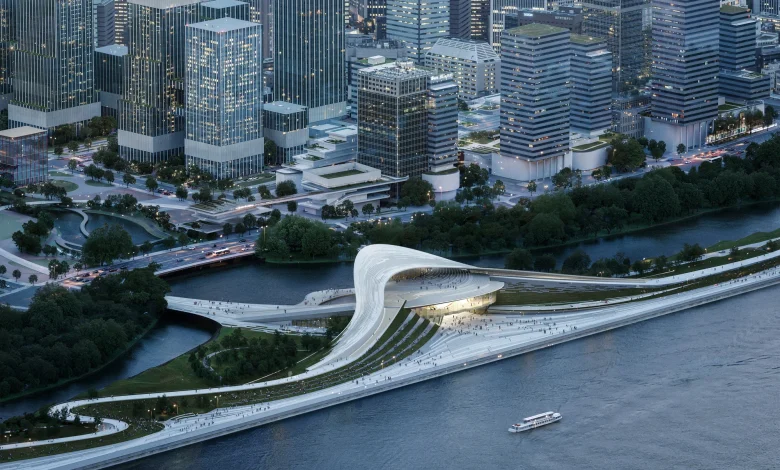Snøhetta Selected to Design the New Qiantang Bay Art Museum in Hangzhou, China

Qiantang Bay Art Museum design by Snøhetta. Render. Image Courtesy of Snøhetta
Share
Share
Or
https://www.archdaily.com/1035808/snohetta-selected-to-design-the-new-qiantang-bay-art-museum-in-hangzhou-china
Snøhetta has been selected to design the Qiantang Bay Art Museum, a new cultural landmark within the Qiantang Bay Future Headquarters development in Xiaoshan District, Hangzhou, China. Conceived in collaboration with the Architectural Design & Research Institute of Zhejiang University Co., Ltd. and Buro Happold, the project encompasses architecture, landscape architecture, and interior design over 18,000 square meters. The museum will form part of Hangzhou’s expanding downtown area along the Qiantang River, serving as an important destination for art, culture, and public life.
Qiantang Bay Art Museum design by Snøhetta. Render. Image Courtesy of Snøhetta
Located at the confluence of the Qiantang River and the Central Water Axis, the museum occupies a strategic site with direct metro access and broad visual connections to both waterways. Snøhetta’s concept is meant to embrace the duality of this context, between nature and the city, interpreting the flow of water as a metaphor for artistic and cultural movements through time. Positioned as a “gateway for imagination,” the museum seeks to link the district’s cultural cluster with the riverfront, symbolically channeling creativity from Hangzhou’s urban core toward its defining natural landscape.
Qiantang Bay Art Museum design by Snøhetta. Render. Image Courtesy of SnøhettaQiantang Bay Art Museum design by Snøhetta. Render. Image Courtesy of Snøhetta
The building takes the form of two interwoven, wave-like volumes inspired by the fluid motion of water and the connective structure of a bridge. This configuration organizes all circulation routes around a central node, establishing a dynamic public realm that encourages exploration and interaction. The undulating topography guides visitors across the site, leading them through a rhythmic sequence of outdoor and indoor experiences and culminating in a rooftop terrace offering panoramic views of the river and city skyline.
Related Article
Shifting Sediments: Rivers as an Architectural and Cultural Catalyst
In terms of landscape architecture, meandering pathways extend the terrain into the interior, connecting the built form with the natural setting. On the north side, promenades follow the riverscape toward elevated viewpoints, while on the east, bridge-like walkways transition from the urban context into the museum. At ground level, a central Gateway serves as both a spatial and symbolic connector, drawing visitors toward the water’s edge and framing views of the Qiantang River. Inside, the museum’s core hosts its main exhibition halls, surrounded by open areas for social interaction, education, and cultural exchange.
Qiantang Bay Art Museum design by Snøhetta. Render. Image Courtesy of Snøhetta
Other recent projects that make the most of their waterfront settings include Renzo Piano Building Workshop’s (RPBW) Isola della Musica, a new opera house and convention center in Hanoi, Vietnam, which recently broke ground. In Australia, RSHP announced the completion of the Barangaroo South Masterplan in Sydney, marking the culmination of a 15-year redevelopment that reconnects the city’s northwestern harbor edge with its urban core. In France, Bjarke Ingels Group (BIG) has unveiled the design for a new congress center in Rouen, distinguished by a sweeping timber roof that echoes the city’s historic relationship with the water. Earlier this year, MVRDV revealed its design for rock-like tourist facilities and infrastructure along the coastal area of Jialeshui, a scenic destination at the southern tip of Taiwan.





